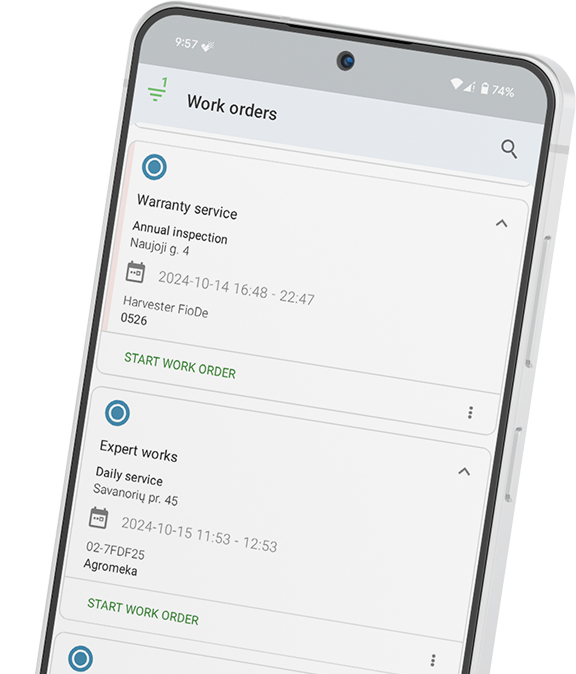Bring simplicity to your field service operations.
Our list of integrations is updated frequently. Explore each integration in its own separate page for more information.
A few weeks back we took a deep dive into maintenance management software, why you need it, and the factors to consider when choosing one. We even talked about more specific maintenance topics such as work order documents and preventive maintenance processes. Today we will talk about the future of maintenance software and what you should expect to see from this technology in the years to come.
Preventive maintenance software was step one in the digital transformation of the field service management industry. As things stand, maintenance management software was able to move all company operations on the cloud and empower maintenance managers to handle scheduled tasks, repair jobs, and maintenance requests through mobile apps.
There’s a lot more potential though. The next generation of preventive maintenance software will see the injection of augmented and virtual reality technologies into space. Let’s use an example to give an idea of what AR/VR can actually do. Picture your maintenance team going out into the field for one of their planned tasks. Instead of pulling out their mobile device to check on the information like the installation date of this specific equipment part, inventory in-store, and replacement date, they put on a special pair of glasses that feeds them real-time data with all the information needed.
The glasses can scan and analyze that component live, allowing technicians to just do their job. The game-changing element of this technology can be broken down to:
That’s the first and obvious impact of AR/VR on preventive maintenance operations. The more nuanced and layered consequence is the actual restructuring of the entire preventive maintenance system. Skilled technicians will actually have the ability to wear their special glasses, never leave the company headquarters and see the job site in real-time. The implications of this scenario are huge as companies will save considerable amounts of money on transportation expenses, time for travel-related expenses as well as enjoy better utilization of their resources.
Experienced technicians can act as managers and guide less-skilled technicians who are on-site to complete a task. Things like quality control and maintenance management will be feasible remotely. This new breed of tech brings outstanding connectivity between maintenance departments and allows for more streamlined maintenance operations.
The maintenance management industry moved from manual, reactive maintenance operations to preventive maintenance software. The natural progression of that journey answers to the name of predictive maintenance and it includes the analysis of equipment conditions, factoring in information such as asset health, asset lifecycle, number of complete tasks, and maintenance schedules to try and predict the best time to service the asset.
Predictive maintenance is the automatic computation of future maintenance activities. It’s a technology that looks at data and builds predictive models for maintenance scheduling software.
One of the biggest challenges for the preventive maintenance industry is the skills gap between the older, more experienced generation of technicians the new hires. Companies have to ensure that knowledge, skills, and capabilities are stored and can be transferred to new employees when they are onboarded. How can you save knowledge, though?
The answer is simple. Computerized maintenance management software of the future will be able to record experienced maintenance professionals at work, creating a library of use cases, case studies, and how-to guides for new-joiners. Maintenance software won’t simply be a way of resolving regular maintenance/routine tasks, but an educational tool, an asset of intellectual property.
Not only will companies bridge the skills gap, reduce costs and save money, but a guide on how to perform jobs efficiently.
At this point in time, preventive maintenance software is mainly used for asset tracking, giving some basic asset life insights. The more this technology improves, the more preventive maintenance software will turn into asset maintenance software.
Solutions will not only perform the basic functions of an enterprise asset management software which are recording, documenting, and managing work orders but they will be able to automate decision-making based on performance. An asset performance management solution will be able to provide maintenance teams and facilities managers with continuous insights on how to optimize asset performance and longevity.
The algorithm and technology will get “smarter”, increase customer satisfaction, boost uptime, extend asset life, and simplify inventory management. This version of an asset management solution will be smarter, quicker, and more efficient than the best preventive maintenance software we have in the market today.
Connected devices and the use of artificial intelligence is hot topic for any industry that deals with technology and preventative maintenance software is no exception. The future of increased IoT use in the industry is to increase the amount and quality of data collected. This will give maintenance teams the power to turn maintenance operations from a cost center to a profit center.
IoT technology will cause a rise in facility automation solutions that will in turn bring the necessary preventive maintenance software adjustments. People will be continuously connected to their mobile devices controlling the heating, air conditioning, lighting, and music in their house. More use will cause more friction and subsequently, a higher possibility for malfunctions. Maintenance software will now have to take into consideration software maintenance as all of these systems will be run through the cloud.

Our list of integrations is updated frequently. Explore each integration in its own separate page for more information.

Link copied!